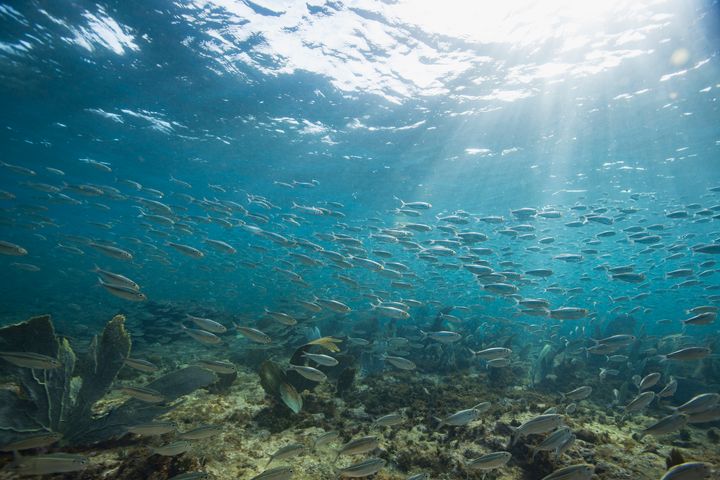
School of silversides near Maria Island, part of the Pointe Sables Environmental Protection Area (PSEPA), which is part of the Conservancy's Eastern Caribbean Marine Managed Areas Network project.
This week, experts and decision makers from around the world gather at the United Nations in New York—to focus on the commitment made by nations in 2015 to protect the health of the ocean. Voluntary agreements have been pledged across the spectrum, from industries to NGOs, in support of Sustainable Development Goal (SDG) 14 “Life Below Water”. Under the rallying call to “conserve and sustainably use the oceans, seas and marine resources for sustainable development”, these commitments amount to a wonderful 754 to date, and are growing by the hour. In the same line, UN countries have recently agreed on a Call to Action that is setting the path for action after this meeting and until 2025.
At The Nature Conservancy, we are committed to ensuring that conservation remains an indispensable partner in ocean development—in the spirit of protecting people and nature. The ocean represents an estimated $1.5 trillion in global value added, yearly. Economies globally depend on a healthy ocean—from large-scale fisheries to subsistence fishermen; from international luxury hotel chains to the 3 billion people dependent on seafood as their primary source of protein. Beyond these critical economic contributions, there is deep value in the cultural, spiritual, and scientific benefits of the ocean—a crucial, intrinsic value which we cannot quantify.
With this incredible potential in mind, we are contributing our scientific and financial know-how to enabling informed, data-driven and measurable decision making- applied across our regional projects, our partnerships, and our policy work in international fora such as this one. We all depend on the ocean, and are collectively responsible for its well-being—understanding its value, and thus the cost of inaction, is crucial in insuring we treat the ocean like any other asset we depend on.
In line with this mission, The Nature Conservancy has also made voluntary commitments towards the effective implementation of SDG 14, including:
- Towards achieving Coastal Risk and Resilience, we aim to protect and finance nature-based coastal adaptation for vulnerable coastal communities and economies. In that vein, we are partnering with risk-modeling and re-insurance companies. We are working with Swiss Re, one of the world’s largest reinsurance companies, to help understand the economics of nature-based coastal defenses. Through this partnership, we are exploring how new nature-based insurance products can protect and finance ecosystem based coastal adaptation.
- Through our “Mapping Ocean Wealth” project, we aim to deliver specific local data about the invaluable services the oceans provide, allowing us to evaluate nature as an economic asset. By 2030, we aim to have data applied to 10 countries in 3 regions to inform investments in conservation and use of ocean resources that contribute to Blue Growth.
- We will continue to work with public and private partner organizations towards enabling accurate fisheries management decisions and monitoring, using our tools such as FishPath.
- We are also supporting the commitments of several other organizations and initiatives, including the Global Mangrove Alliance, International Alliance to Combat Ocean Acidification, Seychelles Conservation and Climate Adaptation Trust (SeyCCAT), and the Coral Triangle Initiative.
Another important focus for us—one that is particularly close to my heart—is the crucial importance of protecting the high-seas, which represent 50% of our planet. These are ocean areas that lie outside of any nation’s jurisdiction—under little control, they are currently poorly managed and increasingly threatened by expanding industrial activities and climate change. It falls upon the United Nations to act to protect and manage the high seas, and in 2015 world governments agreed to convene four sessions to frame a potential new high-seas conservation agreement. This coming July, the fourth and final of these meetings will hopefully deliver a decision to hold diplomatic talks, beginning in 2018, leading towards a binding treaty.
Global collaboration towards protecting half of our planet’s surface is momentous. Together with our partners in the High Seas Alliance, we will do all we can to support the process in favor of a binding treaty whilst in New York this week. You can follow these activities using: #thisway2treaty.
I am also delighted that The Nature Conservancy is a key supporter of the “Tuna 2020 Traceability Declaration”, which is convened under the auspices of the Word Economic Forum. The Declaration includes commitments which are endorsed by leaders of the world’s biggest retailers, tuna processors, marketers, traders and/or harvesters, with the support of influential civil society organizations, and governments. Commitments include a pledge for fully traceable tuna supply chains, the elimination of slavery within these supply chains, and sourcing from fisheries with robust science-based management plans. In 2014, global landings of the seven most commercially important tuna species reached an estimated end-product value of over US $40 billion—this is an incredible value we must manage sustainably and ethically.
This is a big week for the ocean—the need to conserve and sustainably manage our ocean, seas and marine resources is enshrined in the SDGs and in multiple global partnerships and projects. It is exciting to see so many voluntary commitments which complement partnerships, multilateral agreements and international treaties. We hope for exciting outcomes throughout the next week—keep tuned and follow us all here: #saveourocean; @damanaki.
Explore The Nature Conservancy’s latest thinking, science and recommendations on ocean conservation.